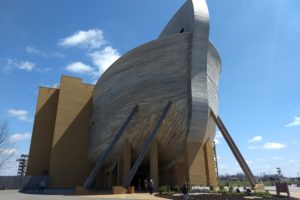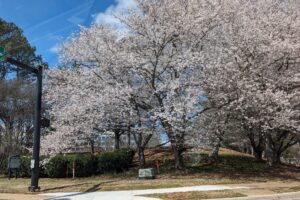You know we love learning about the history of each area we visit. This trip was an eye-opener since we get to see the our Revolutionary War from the British perspective! We’ve done this once before, and it was a challenge to see our history in a whole new way. Our first stop today was at the 2-block historic British Garrison District located along the St. John River.

This building originally served as the quarters for the British officers stationed here. The original structure was build of wood around 1786 but was gradually rebuilt with stone; this structure was completed in 1853. In 1883, Fredericton was honored to be chosen as the first permanent and oldest Canadian military unit, the Royal Canadian Regiment.

one of the city’s most unique and historic areas.
When the British army was garrisoned here from 1785 to 1869 and the Canadian army in 1883 to 1914, the square was the center of military activity. Now it is the site of Changing of the Guard ceremony in the summer, summer outdoor concerts, daily outdoor theater, outdoor films, and a variety of festivals and events all year long.
soldiers’ barracks
A block away, also along the river, is the soldiers’ barracks from 1827. It’s a 3-1/2 story stone structure built to house more than 200 British soldiers. Each room had iron beds for 19 soldiers (so many men sleeping in a room was probably their source of warmth during the winter!). Wooden pegs and shelves held their belongings. The only other furniture was a table and wooden benches.

Being stationed here was considered to be ideal for the soldiers. During the War of 1812, six of the companies from this area made a 52-day march to Quebec and then to Kingston, Ontario, between February and April of 1813 (winter time no less) to provide reinforcements for the fighting there. We actually saw one of these forts and heard about the War of 1812 from the British point of view when we passed through the border crossing at Niagara Falls and drove up to the end where we could see Toronto across Lake Heron.
On the east wall of the barracks (left side of this picture) is a faithful reconstruction of an unusual sundial.


To determine the correct time on the sundial, the following corrections would have to be made.

guard house
Across the public space from the soldiers’ barracks is The Guard House.

Here’s the description of the compound that is on the front of the Guard House. The compound serves as a reminder of the military establishment and its contribution to the early character and development of New Brunswick.

This building was home to a 12-man Main Guard. A soldier in an infantry regiment of 1828 to 1869 could expect to be detailed for either night or day guard at least twice a month. When not pacing his beat, he could rest by reclining in his full kit on a Guard bed of hard plants covered with a thin straw mattress.


On the left side of the building is the administrative room.


The cell block in the back of the building originally had 7 cells—windowless stone and brick cubicles with an air-hole of about 10 inches in diameter in the outer wall. In 1847, the cell block was modified to contain 5 enlarged cells, barred windows, and an escape-proof ventilation system. Too bad we couldn’t see inside the cells to give you a view.


too high for me to take a picture to see inside.
militia arms store
The original arms store is the only remaining wooden structure of the original 4 that were in this district and that have been replaced by stone structures.

Next to the arms store is a more modern armory.

Thanks to the city’s booklet that gave us these wonderful descriptions of these buildings.
why British were here – my simplistic look at New Brunswick’s history for hundreds of years
The background of the Maritime Provinces began with the native peoples. Then the French came and began their fur trading; the French were called the Arcadians at that time. The French and the Indians got along well for the most part. At times, the French were battling other French for control of an area.
Eventually the Loyalists fled north from the 13 colonies when Britain lost the war. The French and the British fought each other all over the known world and also fought each other here. The Indians fought along side the French against the British. Eventually the British won the war with the French, and so we have the British garrison. The Indians didn’t fare well with the British since they had supported the French. Many of the French were kicked out of New Brunswick and relocated to southern Louisiana, which was then owned by the French (remember the Louisiana Purchase when we bought land from the French in 1801?). These transplants settled here and became known as the Cajuns.
Next we’ll walk through the museum in the officers’ quarters and then take a modern-day stroll around the area.




